Going into the World Cup this year, Spain want to recover from their 2018 setback at the Russian World Cup, where they were eliminated by defending champions France. Luis Enrique has turned a doubtful squad into an incredibly talented team that has become a squad of monsters, mentally. The group work from the former Barcelona player has been one of the best in the history of the squad, and he has shut several mouths from the press in his national team career so far.
Young players like Gavi, Pedri, Eric García and Unai Simón have developed into real starlets inside the starting XI despite the critics from outside. They join the likes of Ferran Torres and Alvaro Morata who can offer incredible tactical intelligence thanks to their movements that have made Spain a typically impressive team, in possession.
However, recently Spain has lacked to build a threat in the final third, and their dominance with the ball hasn’t been turned into big opportunities. With fellow European giants Germany, along with a high-octane Japan side and familiar underdogs on the international stage, Costa Rica to overcome in their group, Spain will need to kick their chance creation up a gear in Qatar.
This scout report in the form of a tactical analysis will provide a detailed insight into Spain’s tactics under Luis Enrique. More specifically, this analysis aims to identify why and how Spain come into this World Cup as one of probable shocks.
Predicted starting XI
Goalkeeper Unai Simón is first in the running for Spain’s number one shirt, despite facing competition from players with skills in different phases and stages like Robert Sánchez, David Raya or Kepa Arrizabalaga.
In the back four, we anticipate that the leader who’s adaptable to every situation, César Azpilicueta, starts on the right of the defence, alongside a central defensive duo of Pau Torres and Eric García, with Jordi Alba on the left. Rodri and his great-passing ability plays as the unique ‘6’ alongside Pedri and Koke; Ferran, Sarabia and Morata finish off the starting XI up front. However, names like Dani Olmo or Nico González surely present alternative options who can challenge for a starting XI spot.
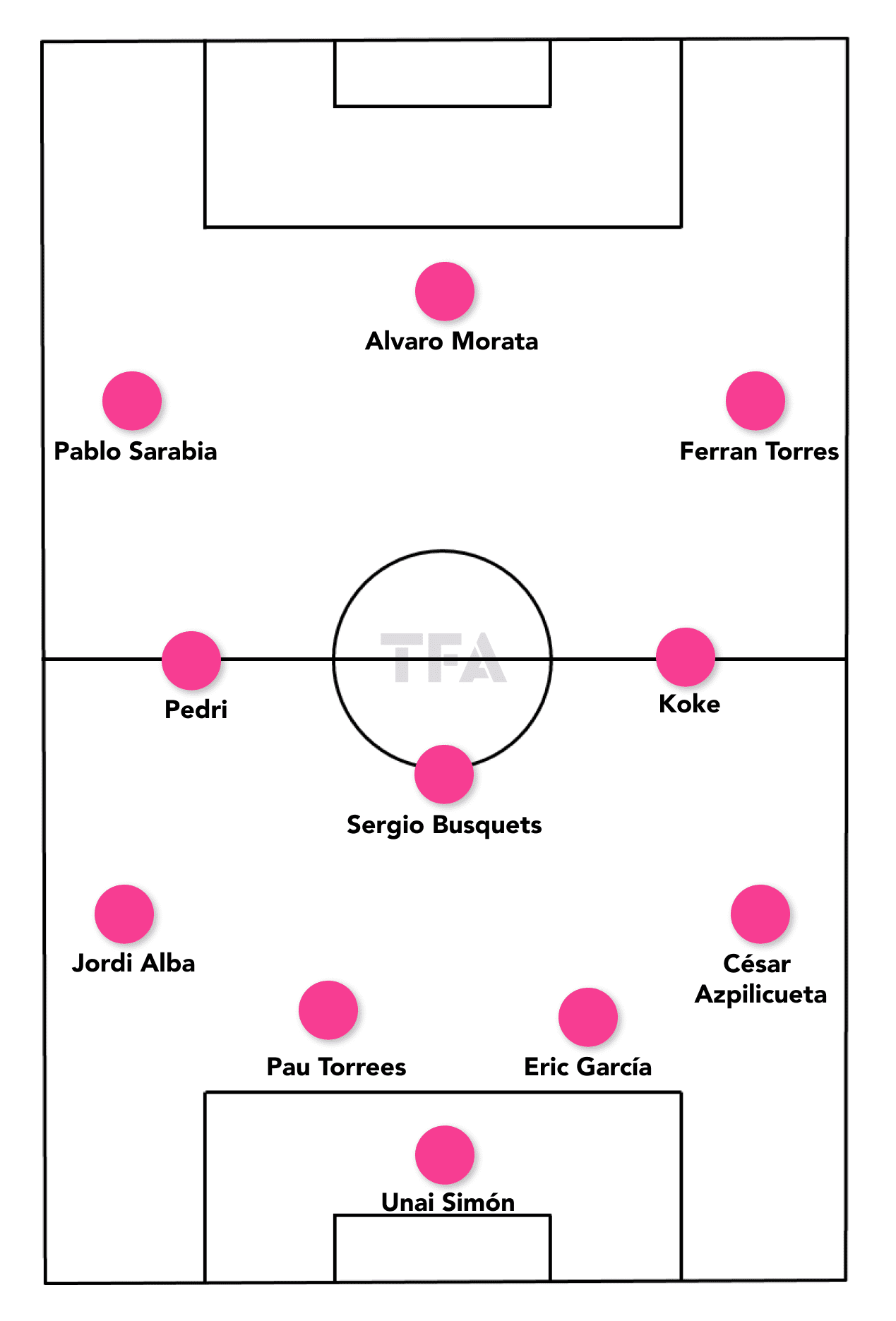
Luis Enrique has started to give plenty of chances to young players such as Gavi, Nico González (who’s not on the viz), Ansu Fati and Eric García in the recent matches ahead of the World Cup. These kinds of players can complement a mostly technically sound squad of players at their peak, joined by some who offer the lasting experience that could make Spain a mentally monstrous team to face, thanks to the desire and intensity of the youth players, those living the best moments of their career right now, and others who’ve been there and done that to complete the group.

Attacking phase
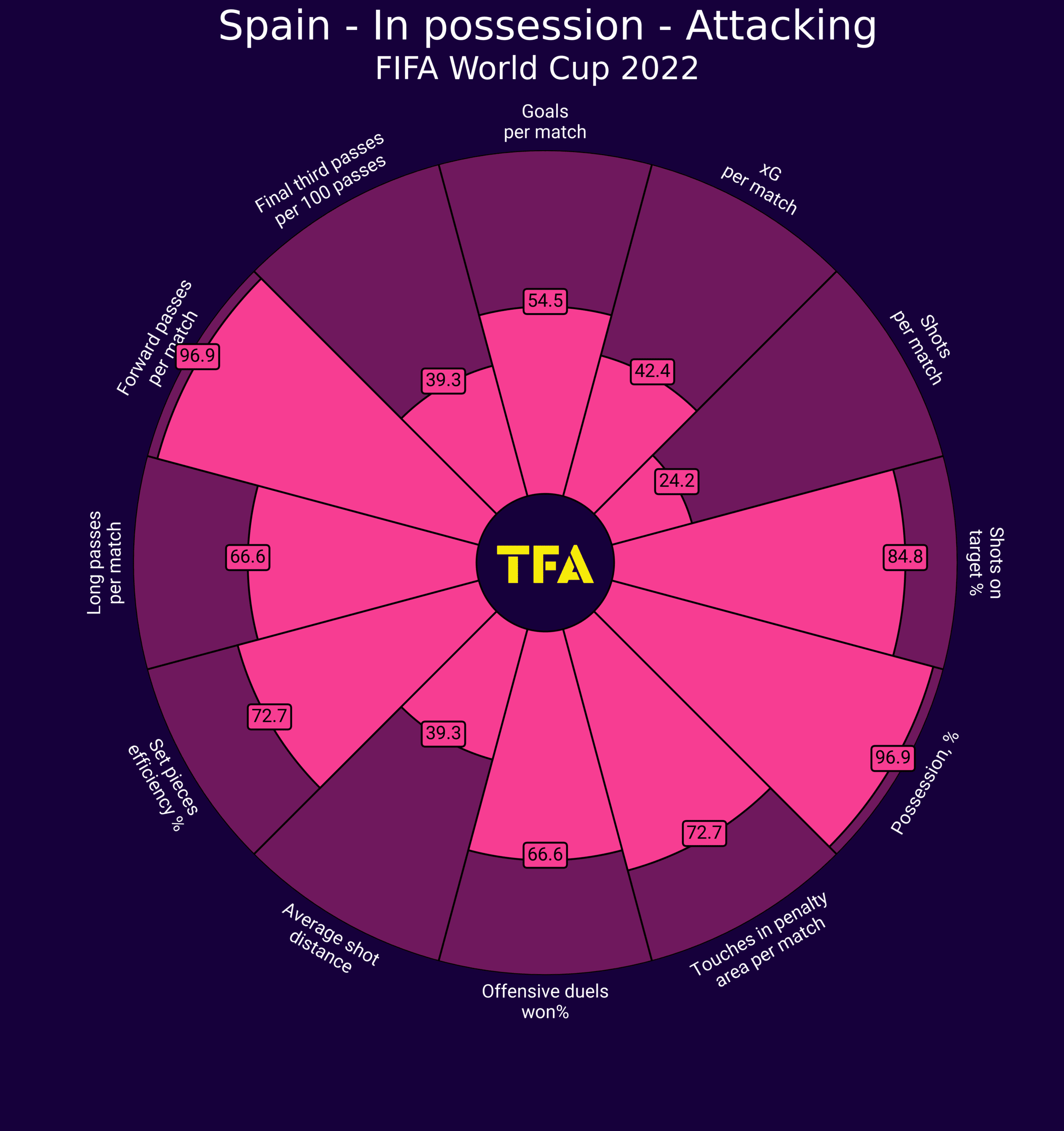
The first impression of what Spain can be offensively is what the data viz above shows us: An incredibly dominant and accurate team in passing terms, being one of the teams that spend the most time with the ball. They can win offensive duels and enter the penalty box; however, the task that has been criticised by their fans is the low percentage of goalscoring chances, as they do not finish up their possessions.
As you would think, Luis Enrique likes his team to play with a possession-based style, making constant overloads with their goalkeeper from the back, centre-backs with a massive technical ability to break lines, and a very fluid and mobile midfield line that can create confusion in markers to appear freely through many zones.
As we can see in the picture below, Spain’s goalkeeper, Unai Simón, plays a pass to his left-centre-back. This player attracts very close pressure before then once again releasing the ball back to the goalkeeper, who then decides to execute a brilliant pass to Rodri, who can receive with time and space to turn and run.
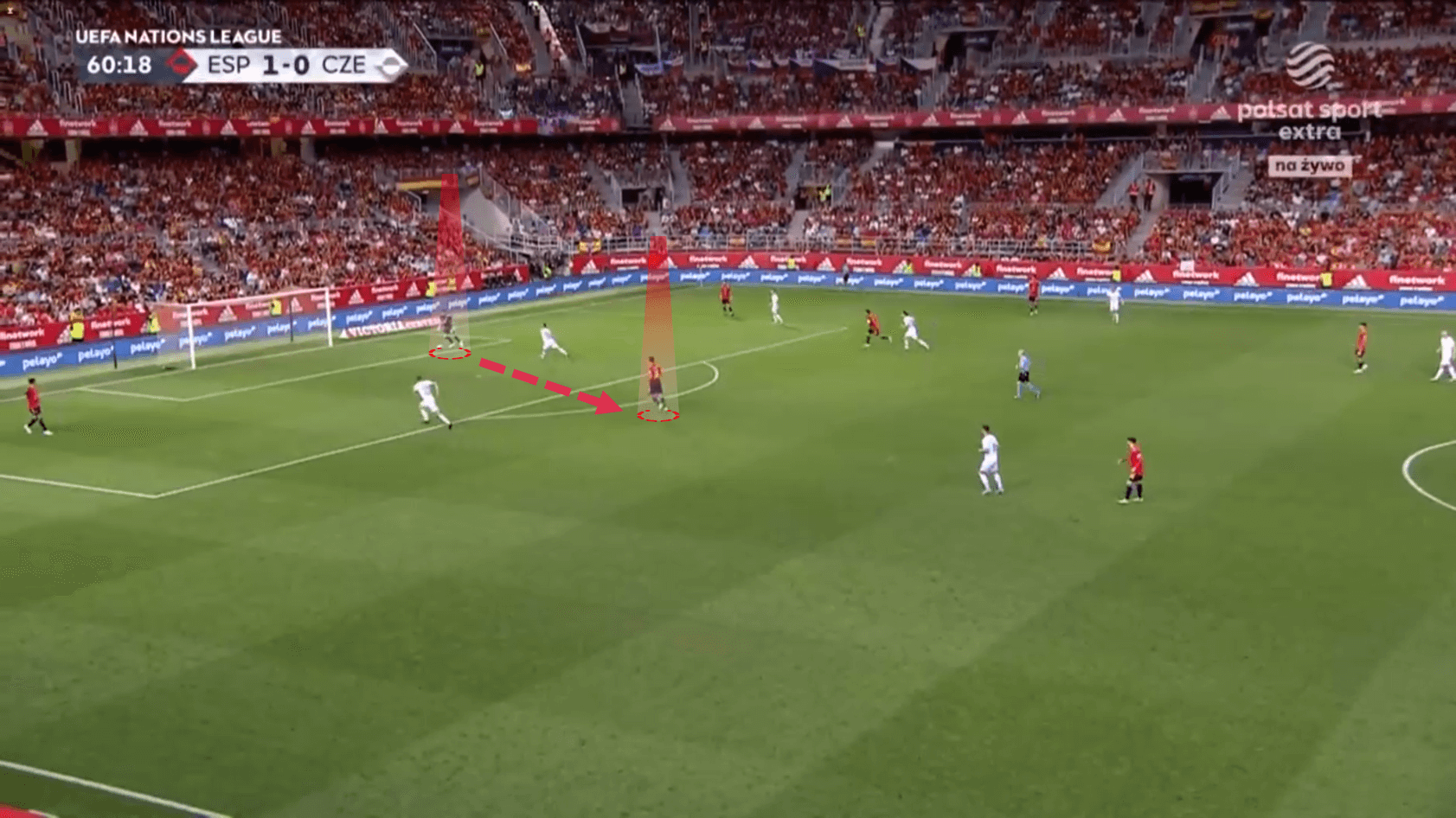
One of the automatisms seen constantly in Spain’s build-up system is how midfielders get closer to centre-backs to attract more rivals. Koke is one of the biggest examples of this; he can play wide, joining the centre-backs to create a back-three or get very deep exchanging positions with Rodri, the pivot.
Here we can see some technical skill that happens often inside Spain’s build-up, where players execute one-touch passes on the half-turn, with Koke choosing to play a risky but excellently executed pass to his centre-back.
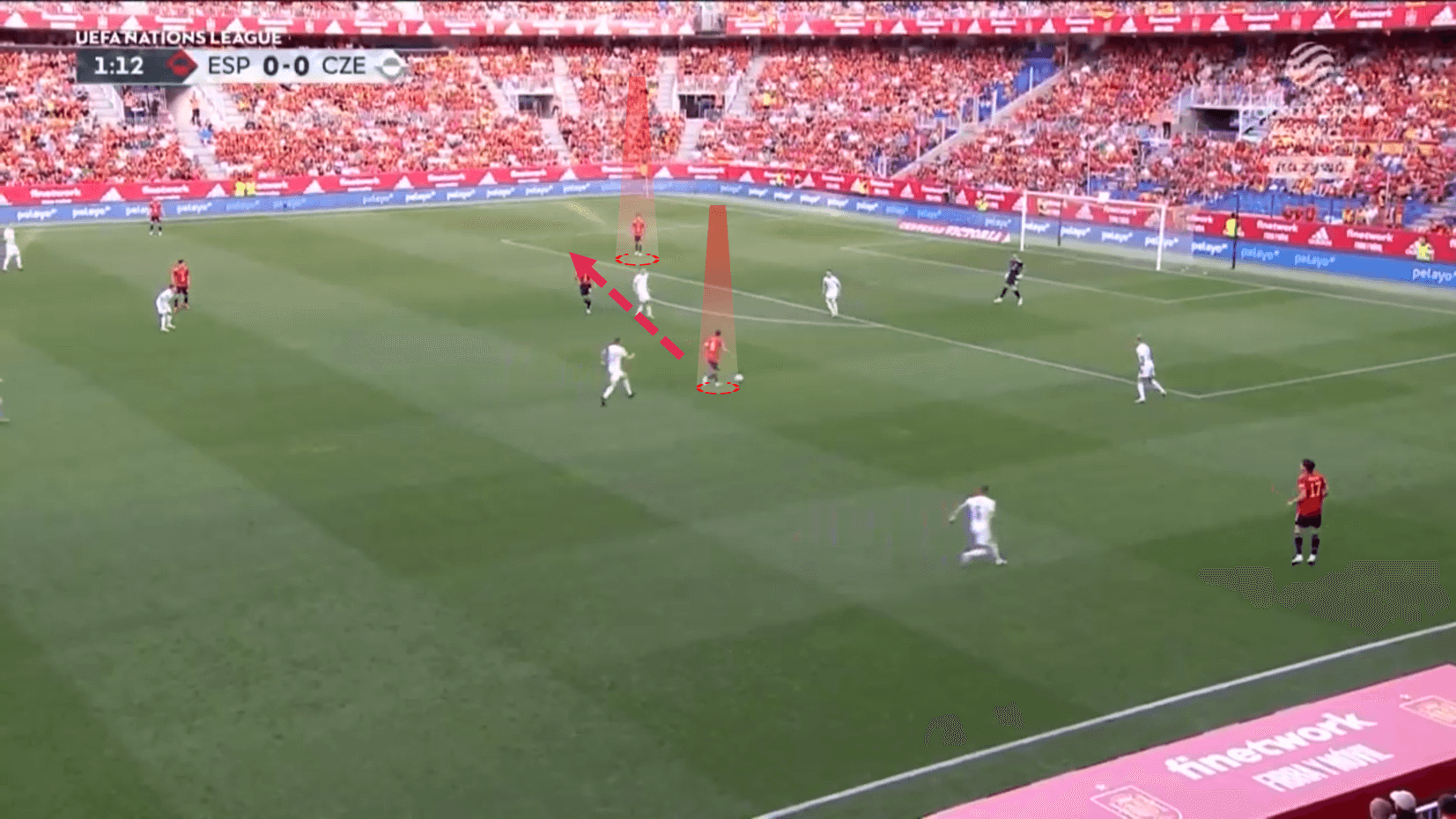
Inverted wingers are also very important in Spain’s attacking phase, as they are very technical and have excellent capacities to play through the middle where they make one-two connections in the central areas to then activate the full-backs out wide. PSG’s Pablo Sarabia is one of the wingers who understands this kind of movement to offer passing options between the lines for their centre-backs better than most.
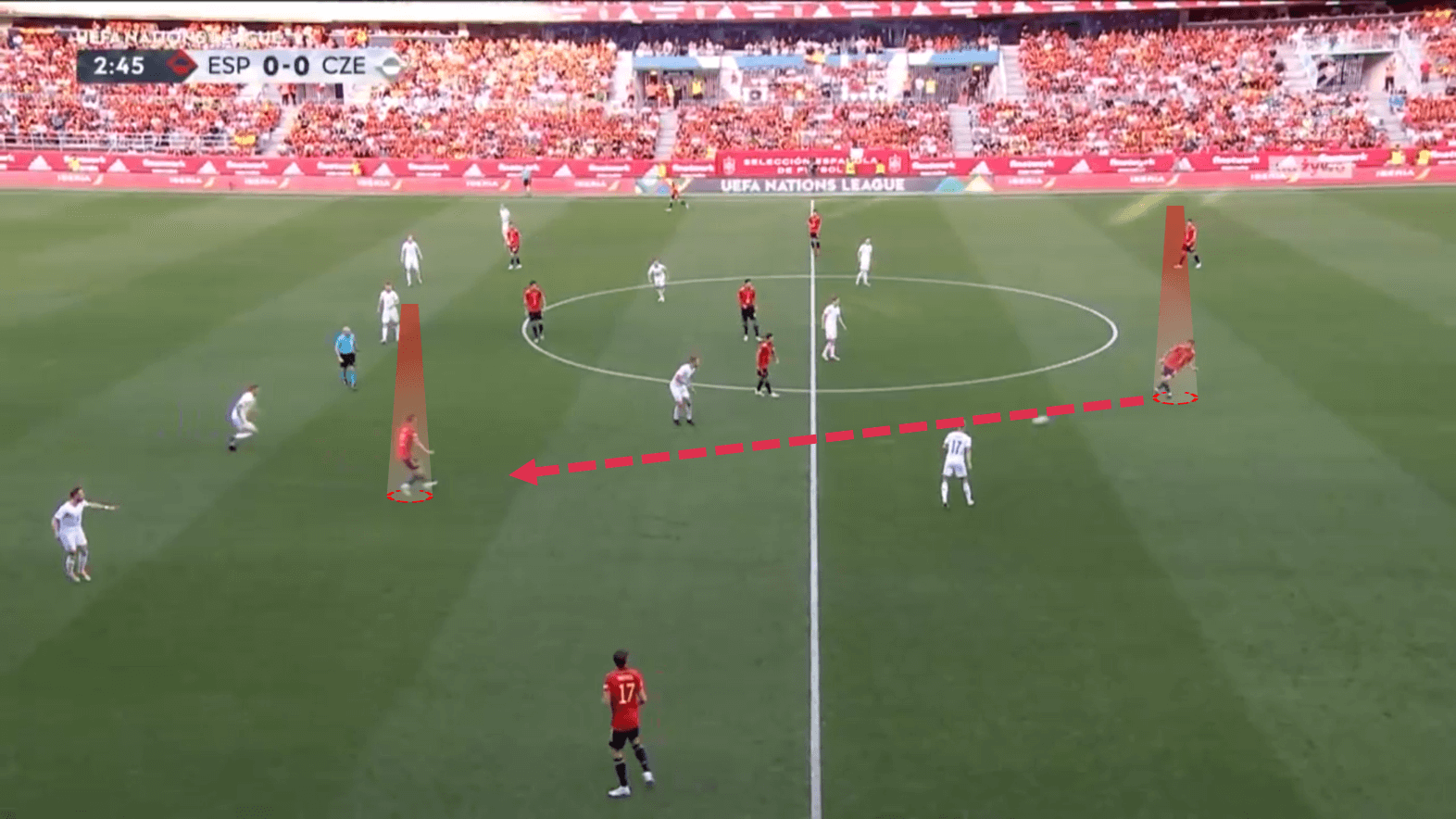
As the wingers often drop from their lines to receive the ball, Morata’s role is a very underrated one. His off-the-ball movements are perfectly done, as he’s one of the most intelligent players in the team to create spaces for his teammates.
Luis Enrique requires Morate to be a very active player in the build-up, playing with his back to goal, retaining and holding markers and releasing excellent through passes or sideways balls to progress in different ways. The example below shows it perfectly: Morata has dropped deep to his own third, receiving a pass from his centre-back to then pass it to the man in front of him.
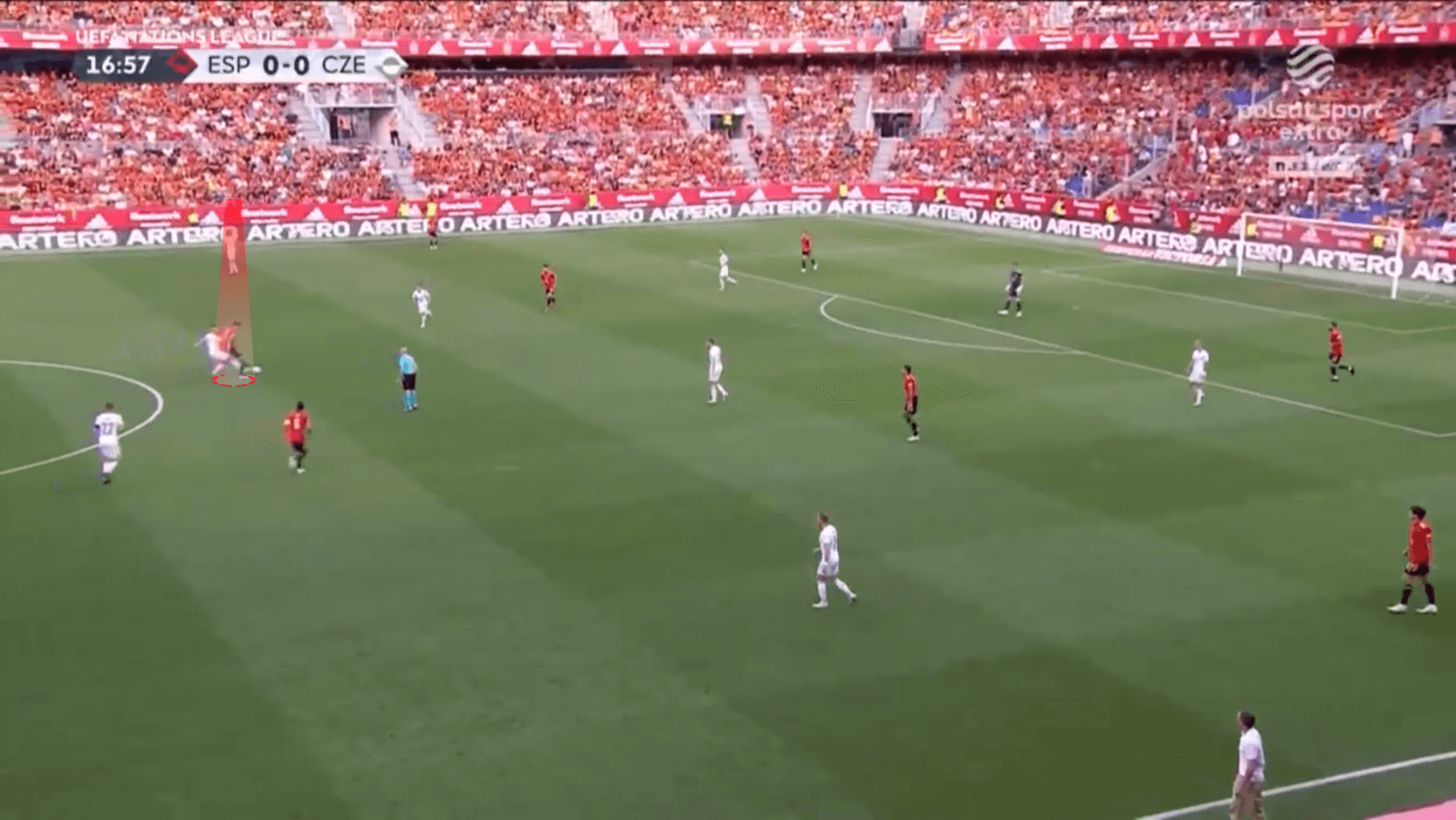
When they move to the middle third, Spain like to play with fast passes that make them travel to the final third quickly. One of the methods that Spain utilise to accelerate possessions and create big chances in the match follows strict movements from the ‘6’ to get wide, push his full-back forward, then pass it to him, who will try to find the inverted winger in the central areas. This is one of the most common ways goals are scored in Luis Enrique’s system.
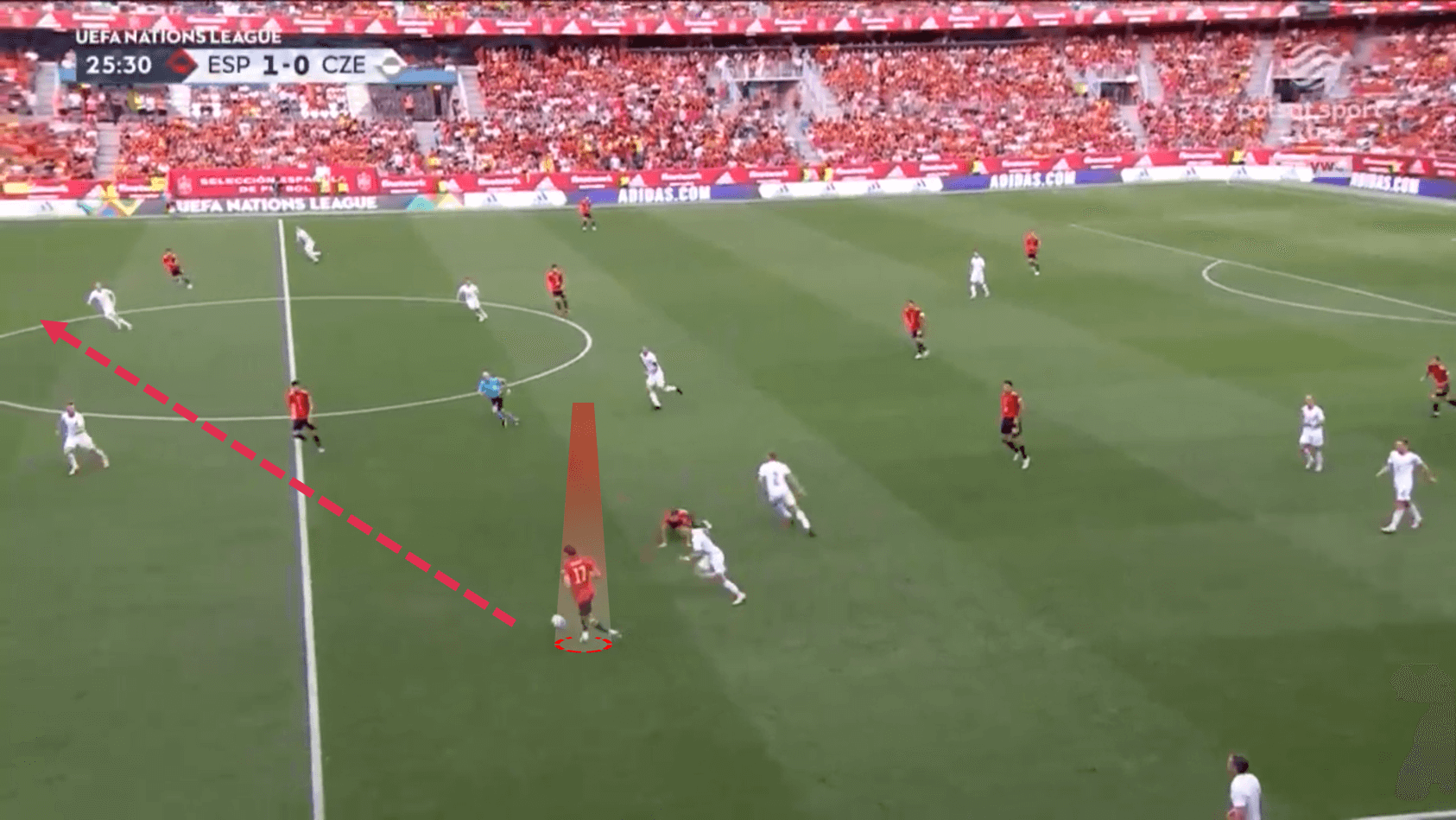
Finally, we can see the attacking shape of Spain: The traditional 2-3-5 applied by offensive-minded and possession-based teams that like to push the full-backs very far forward and display their wingers in an inverted role.
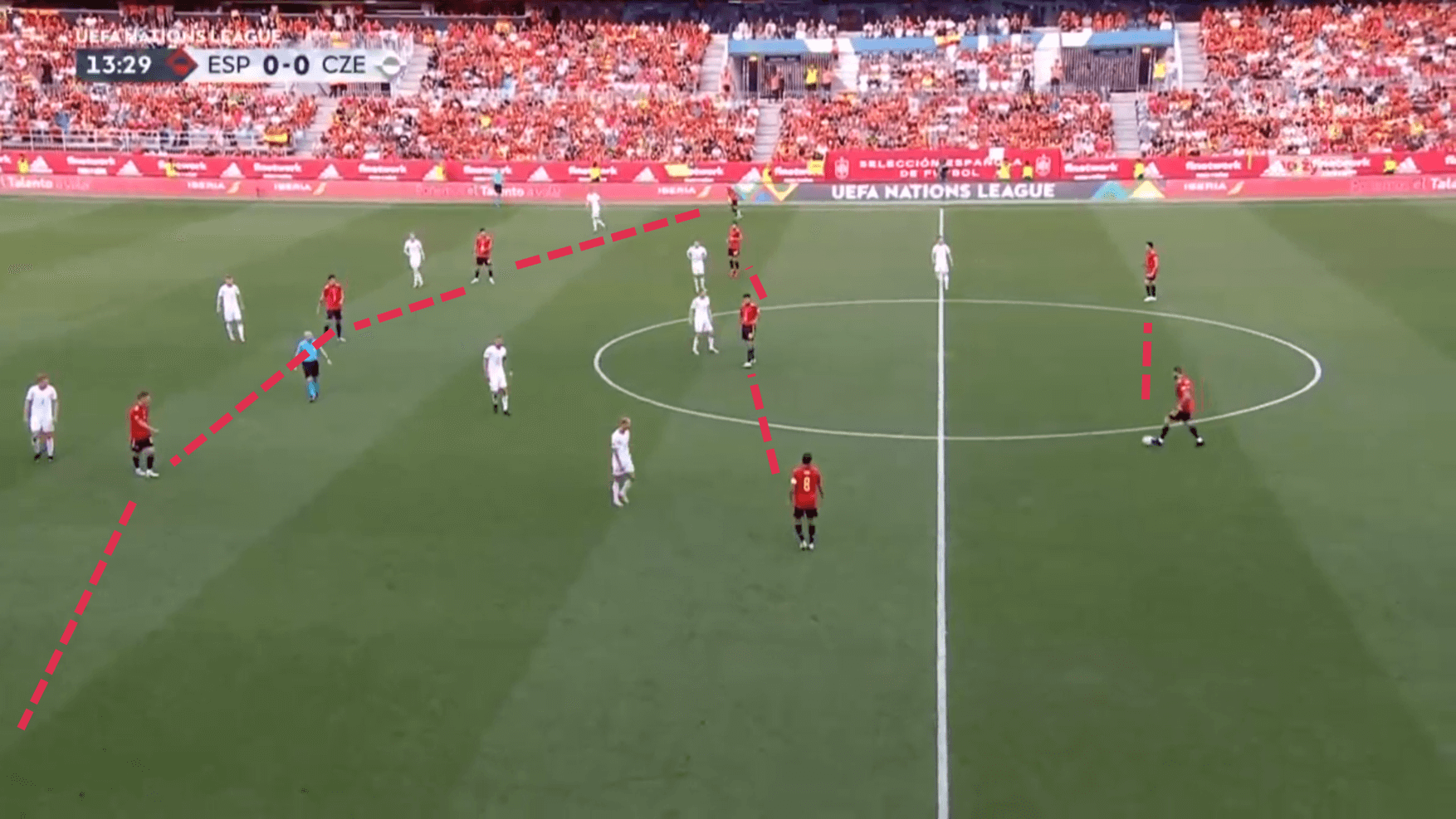
Defensive phase
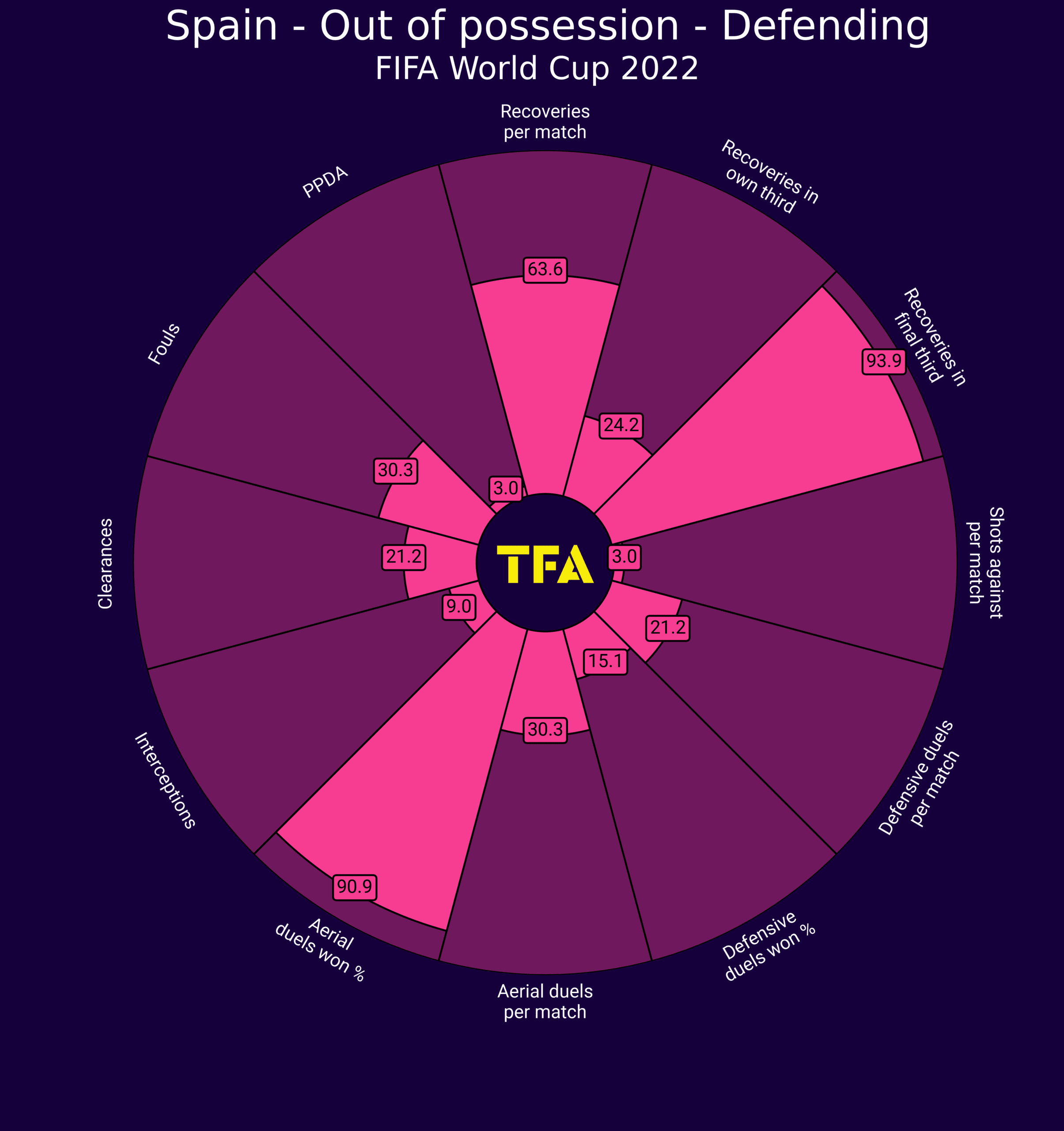
Spain likes to sit in a high block where players tend to defend very tight and close the rivals’ build-up to recover the ball four-to-six seconds after a rival possession; so, it’s clear that pressing high and, even more, counterpressing are key elements of their defensive tactics.
The first line of pressure, firstly, do the task to suffocate holders on the ball and force them to play passes to the central areas, where Rodri, Koke or Pedri make themselves even bigger on the field, thanks to their incredibly intense tackling and pressing.
In almost every match, Spain perform with intensity, acting as a high-pressing team that doesn’t like to sit in their own third or in the middle third. After losses, they tend to be a counter-pressing side to win the ball back very quickly.
The example below shows a moment where Spain was very dangerous in the final third but Dani Olmo made a turnover. The opposition pick the ball back and try to carry it forward, but Luis Enrique’s boys go and press them with intensity before they can escape their own third.
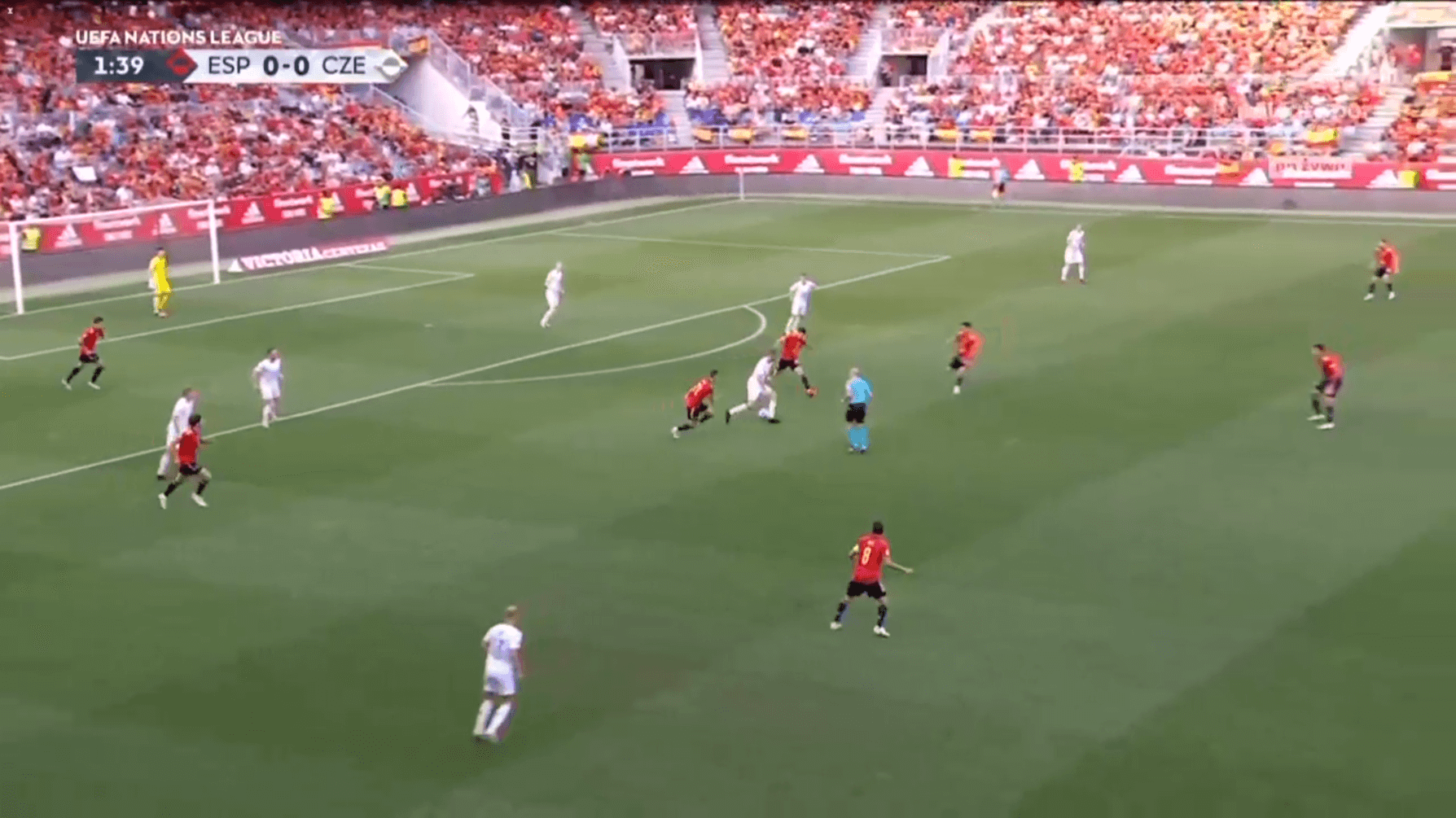
Transitions
In attacking transitions, Spain have the capacity to be a very harmful team with technical players that can execute through passes and carry the ball with great physical power, such as Gavi, Koke or Pedri that can’t be like this, but their lower centre of gravity usually helps them to maintain markers in the runs. Alvaro Morata makes himself key in this phase, and the wingers like to stay very wide.
In defensive transitions, Spain believe in counter-pressing where they go quickly after the players to block not just the passing options but close down the ball carrier with more than three or four players swarming around to intercept and tackle them with an active, intense attitude.
Defenders
In a team with Aymeric Laporte, Pau Torres, Eric García or the versatile César Azpilicueta as options, the defensive selections have to be some of the toughest decisions for Luis Enrique. All of the aforementioned players offer significant input in various phases of the match, including the defensive solidity, especially in Azpilicueta and Laporte.
Midfielders
The midfield line is the best part of Spain’s squad, considering the young and wonderfully talented players like Pedri, Gavi and Carlos Soler. Experienced midfielders like Sergio Busquets or Thiago would surely add even more to this team, balancing with players at their age peak, like the marvellous Rodri or the hard-working Marcos Llorente.
Attackers
Alvaro Morata will surely lead the line in a team where only Ferran Torres can also play in the centre-forward role. Iago Aspas and Borja Iglesias keep waiting for that call that several fans have been asking for many months.
Key player
At 19 years of age, Barcelona’s wonder-kid Pedri has become the centre of creativity for Luis Enrique through the middle — a zone where the Spaniards are comfortable acting in small spaces. This is one of his most important aspects, as he can fight for the ball and dribble beyond two-to-three players that look to block him off. His incredible offensive, tactical and passing capacities at such a young age make him a dream option for Spain.
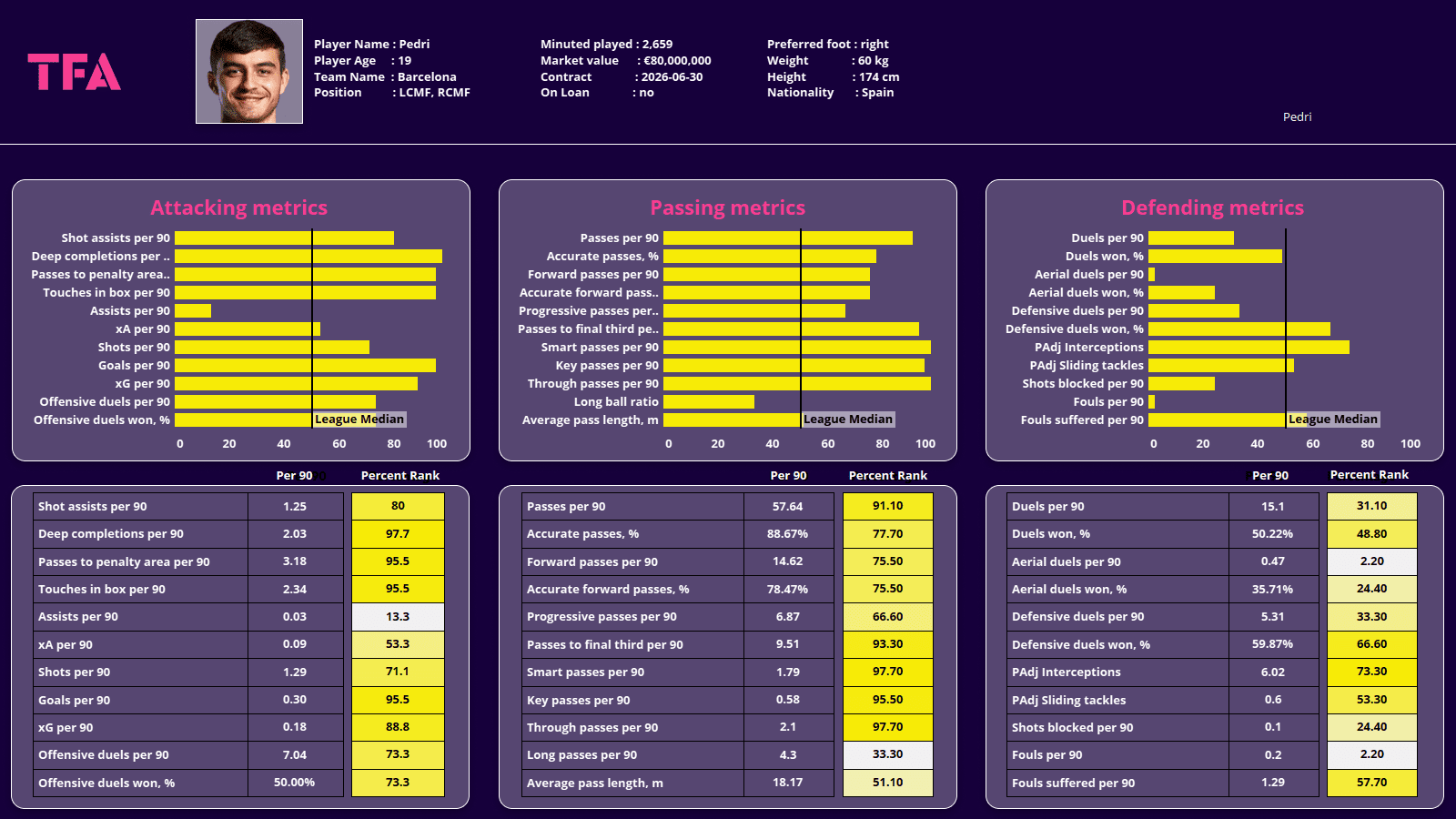
Tournament prediction
Like France, Portugal and the other top teams vying for glory in Qatar that have lacked the ability to turn ball dominance into goalscoring situations of late, Spain have an incredible head-coach on board with excellent tactical and mental strategies and a strong mix of prime, youth and experienced, versatile players that have always shown great capacities to play good football for their national team that the Spanish supporters demand.
Nothing less than a strong, lengthy run in the tournament will please the Spanish fans but if they continue to struggle to convert ball dominance into goalscoring opportunities, they’ll be set up for disappointment in Qatar despite the obvious talent Enrique’s got at his disposal in this elite squad. We predict Spain can at least progress into the quarter-finals, all going to plan but may lack the goalscoring prowess necessary to go all the way.






Comments